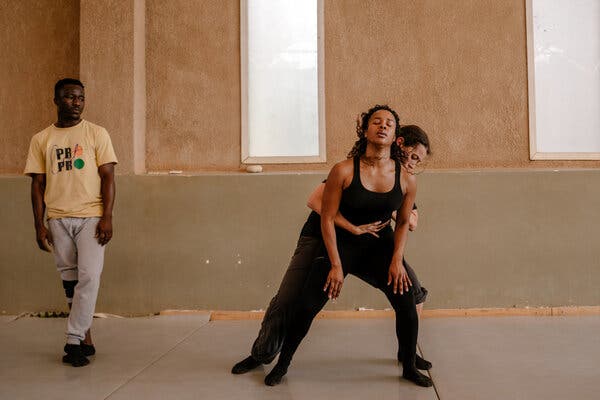Toward the end of Pina Bausch’s “Rite of Spring,” a woman in a wispy white shift walks up to a man and hands him a red dress, a look of terror in her eye. The woman has elected her destiny: To be the “chosen one,” the sacrificial victim who ensures the survival of the collective. But that doesn’t make the outcome any less brutal.
For the next five minutes, she convulses, flings her arms violently, pounds at her legs, and runs in circles, until, with the last note of Stravinsky’s score, she falls, like a stone. It’s harrowing to watch — and to dance.
“You can’t think of anything at that moment,” the dancer Anique Ayiboe said in a video interview in French from Lomé, Togo, where she lives. “You’re dancing against death. I think that Pina wanted to show the fragility of the human body. To show the body in its savage state.”
Ayiboe is one of three women dancing the role of the Chosen One in an ensemble drawn from 14 countries across Africa that has been touring with “The Rite of Spring” since fall 2021. The production finally comes New York, Nov. 29-Dec. 14, performed at the Park Avenue Armory, a suitably epic space for this grand, apocalyptic work.

As elsewhere on the worldwide tour “Rite” will be paired with a new duet, “common ground[s],” for Malou Airaudo, a former Bausch dancer; and Germaine Acogny, the Senegalese dancer and choreographer. (The performances are part of the Dance Reflections festival, sponsored by the jeweler Van Cleef & Arpels.)
The production is an extraordinary transnational collaboration among the Pina Bausch Foundation; Sadler’s Wells in Britain; and the École des Sables, a dance school founded by Acogny in Toubab Dialao, a fishing village outside of Dakar, Senegal. It comes out of the foundation’s efforts to keep Bausch’s dances alive and bring them to an expanding circle of companies and audiences. Bausch died in 2009.
“You have to be active to preserve the work,” Salomon Bausch, Pina’s son and the leader of the foundation, said in an interview from Wuppertal, Germany. “You can’t just put it on a shelf like a painting,” adding that “Rite” is “a nice way to enter Pina’s world.”
Searching for partners, he and the foundation were impressed by the accounts of dancers returning from residencies at the École des Sables. Acogny’s stature as an artist and cultural figure have turned the school into a force in the world of African dance. It attracts students from across the continent who are drawn to her and the technique she developed, which distills elements from different African dance styles. Acogny is often referred to as the “mother of African contemporary dance.” At the school, she is known as Maman Germaine.
Before now, “Rite” has been performed by only a few European ballet companies in addition to Bausch’s Tanztheater Wuppertal, for which it was created in 1975. Salomon Bausch wondered what “Rite” would look like performed by dancers with a variety of dance backgrounds, assembled specifically for that purpose.
Intrigued by the reputation of the École, he contacted Acogny in 2018. The idea immediately resonated with her. “Stravinsky’s ‘Sacre’ has been on my trail for a long time,” she said in an interview in French from her home in Toubab Dialao.
“I’ve always felt that this was an African dance,” she added. “The rituals are the same. And that music has an extraordinary pagan, terrestrial power. I even wonder whether Stravinsky was possessed when he composed it.” For African dancers to perform it, she said, “felt absolutely right.”
The rehearsals confirmed her belief, she said. “I could see that our traditional dances, the technique that I have developed, and urban dance, combined with patience and love, came together to create something extraordinary,” she said. “Because emotion is in the heart, not in the coup de pied” — that is, a particular spot on the ankle that is the focus of intense scrutiny in ballet technique.
Two hundred dancers auditioned, a group that was eventually whittled down to 38. A surprise was the imbalance of genders among the applicants: There were many more men than women — the opposite of what would usually be true in Europe or the United States. “It’s just a reality of our culture,” Ayiboe said. “It’s easier for men to make the decision to dance professionally. Women are supposed to get married and stay home.”
Rehearsals, led by a small group of current and former dancers from Bausch’s company, were held at the École des Sables in early 2020 before the pandemic. (Covid forced the tour to be postponed for a year and a half, to fall 2021, requiring a second rehearsal period.)
The challenge was to shape a group with different training, many of whom had never seen a work by Bausch, into a unified ensemble. In previous stagings, all the dancers came from the same discipline — ballet. Here, some were trained in traditional dance forms, others in urban dances like hip-hop; some had training in contemporary dance; a few had studied ballet. Several were former students of the École des Sables.
“At first it was a shock for me,” Babacar Mané, from Senegal, who started out in hip-hop, said in an interview in French. “Using certain parts of your body that you’re not used to using; responding to certain sounds in the music. It has taken years. Even now, I’m learning.”
“We had to be very patient with each other, because they were touching for the very first time the vocabulary of Pina,” said Clémentine Deluy, a former Bausch dancer who is a stager from the foundation. “We were starting from scratch, going bit by bit, step by step, adding a little bit more every day.”
The instructors subdivided the dance into short phrases of movement, which they demonstrated, and the dancers imitated. When simple imitation fell short, the stagers went deeper, explaining the principles behind Bausch’s movement style. “You can only copy to a certain point,” said Jorge Puerta Armenta, a stager. “After that, you need to understand where the movement is coming from.”
What made the process particularly exciting, Armenta said, was the dancers’ hunger to master this choreography. Many learned not just one role, as is customary, but several. On any given night, a particular dancer may be performing one of a handful roles.
“I’ve done all the male roles,” Mané said. “It gives you a different way of seeing things, and it really stretches your memory. You have to be ready for the challenge.”
Acogny sees a deeper lesson as well: “They encourage each other. There’s no competition. It’s a great lesson in humanity.”
As the dancers learned “The Rite of Spring,” Acogny and Malou Airaudo were creating their duet, “common ground[s],” in another studio. Their partnership was born out of a desire that the collaboration between the École and the Bausch Foundation not be one-sided. “It couldn’t be just the Europeans bringing something to us,” Acogny said. “There had to be an exchange.”
Airaudo, who joined Bausch’s company in 1973 and who has danced the role of the “Chosen One” many times, met Acogny in 2018 in Paris, then again in Wuppertal. Acogny is 79, Airaudo, 75; both have long histories in dance. Their conversations eventually led to a dance, created at École des Sables — in a studio without walls. Sometimes they would pause and sit, side by side, looking out into nature. “We sat there, with our back to the others, looking out at the baobab trees, the sky, the birds,” Airaudo said in a phone interview from Berlin. This image is how the piece begins.
On a walk together around the grounds of the École, both women fell. To ease their aching legs, Acogny suggested they soak them in a basin full of water infused with eucalyptus leaves. That, too, is in the piece. Over the course of the work the two women embrace, console each other and walk together, as if embarking on a long journey. “When I walked toward her I had the feeling of going toward a far-off place, as if I were traversing the world,” Airaudo said.
“Common ground[s],” a leisurely and tender piece that is a complete contrast to Bausch’s “Rite of Spring,” comes first on the program. “I think it is a good preparation for the arrival of ‘Rite,’” said Acogny, “because it’s like the passing of something from one generation to the next. And then the stage erupts like a pressure cooker.”
During the pause in between, the stage is covered in a thick layer of peat. In “The Rite of Spring,” the dancers’ feet move through it, and as the dance progresses, it begins to cling to their clothes and their skin.
This earthy substance makes Bausch’s “Rite” feel less like a dance and more like a lived experience, visceral and raw.
But for these dancers, the sensation of dancing on earth has other connotations as well. “In Africa, we often dance on sand,” said Malé. “So when I step on it, it brings be back to something I know.”
It is also part of the ritual built into the dance itself. “When I feel that fresh earth on my feet,” Ayiboe said, “I know it has begun.”
This post was originally published on this site be sure to check out more of their content.






